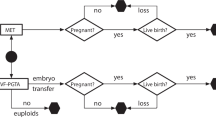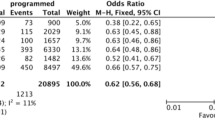Abstract
The developmental potency of pre-implant parthenogentic goat embryos were compared under two chemical activation protocols in three different culture media groups. The in vitro matured oocytes were chemically activated by two protocols viz. P1 (CB-CHX-6DMAP) and P2 (Ca-CHX-6DMAP). The activated oocytes under both the protocols were developed in three culture media, viz. modified synthetic oviductal fluid (mSOF), research vitro cleave medium (RVCL), and RVCL-Blast. While comparing the developmental potential of activated oocytes, it was observed that the oocytes activated under P2 protocol pooled over three culture media group producing significantly higher mean cleavage rate (43.2 ± 0.9 vs 40.6 ± 1.5), blastocyst development (16.4 ± 1.1 vs 12.6 ± 0.8), and blastomere count (120.7 ± 4.7 vs 113.2 ± 4.1) as compared to P1 protocol. The comparison of effect of culture media pooled over protocol groups revealed that the mean cleavage rate observed under RVCL-Blast (44.8 ± 1.3) and RVCL (45.3 ± 0.5) were significantly higher (P ≤ 0.01) than mSOF (35.8 ± 1.2). However, the mean blastocyst development observed under RVCL-Blast group (18.8 ± 3.2) was significantly higher than RVCL (14.0 ± 0.8) and mSOF (10.8 ± 0.4). Similarly, the mean blastomere count under RVCL-Blast group (136.0 ± 3.7) was significantly higher (P ≤ 0.01) than RVCL (114.7 ± 1.0) and mSOF (100.2 ± 0.5) groups. The semiquantitative RT PCR analysis showed the expression of pro-apoptotic caspase 3 gene in P1 and anti-apoptotic Mcl-1 gene in P2. This study concludes that the activation protocol P2 and embryo cultured under RVCL-Blast group were optimum for chemical activation and culture medium, respectively.


Similar content being viewed by others
References
Abe H.; Hoshi H. Evaluation of bovine embryos produced in high performance serum-free media. J. Reprod. Dev. 49: 193–202; 2003.
Balakier H.; Tarkowski A. K. Diploid parthenogenetic mouse embryos produced by heat-shock and cytochalasin B. J. Embryol. Exp. Morphol. 35: 25–39; 1976.
Bos-Mikich A.; Swann K.; Whittingham D. G. Calcium oscillations and protein synthesis inhibition synergistically activate mouse oocytes. Mol. Reprod. Dev. 41: 84–90; 1995.
Chatot C. L.; Ziomek C. A.; Bavister B. D.; Lewis J. L.; Torres I. An improved culture medium supports development of random-bred 1-cell mouse embryos in vitro. J. Reprod. Fertil. 86: 679–688; 1989.
Chen Z.; Liu Z.; Huang J.; Amano T.; Li C.; Cao S.; Wu C.; Liu B.; Zhou L.; Carter M. G.; Keefe D. L.; Yang X.; Liu L. Birth of parthenote mice directly from parthenogenetic embryonic stem cells. Stem Cells 27: 2136–2145; 2009.
Chohessy J. G.; Zhuang J.; Deboer J.; Gil-Gomez G.; Brady H. J. Mcl-1 interacts with truncated Bid and inhibits its induction of cytochrome release and its role in receptor mediated apoptosis. J. Biol. Chem. 281: 5750–5759; 2006.
Collas P.; Robl J. M. Factors affecting the efficiency of nuclear transplantation in the rabbit embryo. Biol. Reprod. 42: 877–884; 1990.
Collas P.; Sullivan E. J.; Barnes F. L. Histone H1 kinase activity in bovine oocytes following calcium stimulation. Mol. Reprod. Dev. 34: 224–231; 1993.
Crosier A. E.; Farin P. W.; Dykstra M. J.; Alexander J. E.; Farin C. E. Ultrastructural morphometry of bovine blastocysts produced in vivo or invitro. Biol. Reprod. 64: 1375–1385; 2001.
Cuthbertson K. S. R.; Whittingham D. G.; Cobbold P. H. Free Ca2+ increases in exponential phases during mouse oocyte activation. Nature 294: 754–757; 1981.
Ducibella T.; Huneau D.; Angelichio E.; Xu Z.; Schultz R. M.; Kopf G. S.; Fissore R.; Madoux S.; Ozil J. P. Egg-to-embryo transition is driven by differential responses to Ca2+ oscillation number. Dev. Biol. 250: 280–291; 2002.
Feugang J. M.; Van Langendonckt A.; Sayoud H.; Rees J. F.; Pampfer S.; Moens A.; Dessy F.; Donnay I. Effect of pro-oxidant agents added at the morula/blastocyst stage on bovine embryo development, cell death and glutathione content. Zygote 11: 107–118; 2003.
Gjorret J. O.; Hiemke M. K.; Steph J. D.; Birthe A.; Larsson L.; Maddox-Hyttel P. Chronology of apoptosis in bovine embryos produced in vivo and in vitro. Biol. Reprod. 69: 1193–1200; 2003.
Gordo A. C.; Wu H.; He C. L.; Fissore R. A. Injection of sperm cytosolic factor into mouse MII oocytes induces different developmental fates according to the frequency of Ca2+ oscillations and oocyte age. Biol. Reprod. 62: 1370–1379; 2000.
Gordon I. Laboratory production of cattle embryos. In: Biotechnology in agriculture series, 2nd Edition, CAB International, Wallington. pp 27; 2003.
Jena M. K.; Malakar D.; De A. K.; Garg S.; Akshey Y. S.; Dutta R.; Sahu S.; Mohanty A. K.; Kaushik J. K. Handmade cloned and parthenogenetic goat embryos—a comparison of different culture media and donor cells. Small Ruminant Res. 105: 255–262; 2012.
Kharche S. D.; Goel P.; Jha P. K.; Goel A. K.; Jindal S. K. Factors influencing in-vitro embryo production efficiency of caprine oocytes: a review. Indian J. Anim. Sci. 81(4): 344–361; 2011.
Kim N. H.; Simerly C.; Funahashi H.; Schatten G.; Day B. N. Microtubule organization in porcine oocytes during fertilization and parthenogenesis. Biol. Reprod. 54: 1397–1404; 1996.
Knijn H. M.; Wrenzycki C.; Hendriksen P. J.; Vos P. L.; Herrmann D.; Van der Weijden G. C.; Niemann H.; Dieleman S. J. Effects of oocyte maturation regimen on the relative abundance of gene transcripts in bovine blastocysts derived in vitro or in vivo. Reproduction 124: 365–375; 2002.
Küpker W.; Diedrich K.; Edwards R. G. Principles of mammalian fertilization. Hum. Reprod. 13: 20–32; 1998.
Lane M.; Gardner D. K. Embryo culture medium: which is the best? Best Pract. Res. Clin. Obstet. Gynecol. 21: 83–100; 2007.
Liu L.; Yang X. Interplay of maturation-promoting factor and mitogen-activated protein kinase inactivation during metaphase-to-interphase transition of activated bovine oocytes. Biol. Reprod. 61: 1–7; 1999.
Liu L.; Ju J. C.; Yang X. Differential inactivation of maturation-promoting factor and mitogen-activated protein kinase following parthenogenetic activation in bovine oocytes. Biol. Reprod. 59: 537–545; 1998a.
Liu L.; Ju J. C.; Yang X. Parthenogenetic development and protein patterns of newly matured bovine oocytes after chemical activation. Mol. Reprod. Dev. 49: 298–307; 1998b.
Liu C. T.; Chen C. H.; Cheng S. P.; Ju J. C. Parthenogenesis of rabbit oocytes activated by different stimuli. Anim. Reprod. Sci. 70: 267–276; 2002a.
Liu L.; Trimarchi J. R.; Keefe D. L. Haploidy but not parthenogenetic activation leads to increased incidence of apoptosis in mouse embryos. Biol. Reprod. 66: 204–210; 2002b.
Loi P.; Ledda S.; Fulka Jr. J.; Cappai P.; Moor R. M. Development of parthenogenetic and cloned ovine embryos: effect of activation protocols. Biol. Reprod. 58: 1177–1187; 1998.
Lorca T.; Cruzalegui F. H.; Fesquest D.; Cavadore J. C.; Méry J.; Means A.; Dorée M. Calmodulin-dependent protein kinase II mediates inactivation of MPF and CSF upon fertilization of Xenopus eggs. Nature 366: 270–273; 1993.
Masui Y.; Markert C. L. Cytoplasmic control of nuclear behaviour during meiotic maturation of frog oocytes. J. Exp. Zool. 177: 129–146; 1971.
Melka M. G.; Rings F.; Holker M.; Tholen E.; Hahlicek V.; Basenfelder U.; Schellander K.; Tesfaye D. Expression of apoptosis regulatory genes and incidence of apoptosis in different morphological quality groups of in vitro produced bovine pre-implantation embryos. Reprod. Domest. Anim. 45: 915–921; 2010.
Motlik J.; Pavlok A.; Kubelka M.; Kalous J.; Kalab P. Interplay between cdc2 kinase, and MAP kinase pathway during maturation of mammalian oocytes. Theriogenology 49: 461–469; 1998.
Murray A.; Solomon M. J.; Kirschner M. W. The role of cyclin synthesis and degradation in the control of maturation promoting factor activity. Nature 339: 280–286; 1989.
Palta P.; Chauhan M. S. Laboratory production of buffalo (Bubalus bubalis) embryos. Reprod. Fertil. Dev. 10: 379–391; 1998.
Presicce G. A.; Yang X. Nuclear dynamics of parthenogenesis of bovine oocytes matured in vitro for 20 and 40 h and activated with combined ethanol and cycloheximide. Mol. Reprod. Dev. 37: 61–68; 1994.
Shah R. A.; George A.; Singh M. K.; Kumar D.; Chauhan M. S.; Manik R.; Palta P.; Singla S. K. Hand-made cloned buffalo (Bubalus bubalis) embryos: comparison of different media and culture systems. Cloning Stem Cells 10(4): 435–442; 2008.
Simon L.; Veerapandian C.; Balasubramanian S.; Subramanian A. Somatic cell nuclear transfer in buffalos: effect of the fusion and activation protocols and embryo culture system on preimplantation embryo development. Reprod. Fertil. Dev. 18: 439–445; 2006.
Smith L. C.; Wilmut I. Influence of nuclear and cytoplasmic activity on the development in vivo of sheep embryos after nuclear transplantation. Biol. Reprod. 40: 1027–1035; 1989.
Susko-Parrish J. L.; Leibfried-Rutledge M. L.; Northey D. L.; Schutzkus V.; First N. L. Inhibition of protein kinases after an induced calcium transient causes transition of bovine oocytes to embryonic cycles without meiotic completion. Dev. Biol. 166: 729–739; 1994.
Walters A. H.; Saacke R. G.; Pearson R. E.; Gwazdauskas F. C. The incidence of apoptosis after IVF with morphologically abnormal bovine spermatozoa. Theriogenology 64: 1404–1421; 2005.
Whitacker M. J.; Patel R. Calcium and cell cycle control. Development 108: 525–542; 1990.
Yi Y. J.; Park C. S. Parthenogenetic development of porcine oocytes treated by ethanol, cycloheximide, cytochalasin B and 6-dimethylaminopurine. Anim. Reprod. Sci. 86: 297–304; 2005.
Acknowledgments
The authors are thankful for the financial support provided by National Agricultural Innovation Project, Indian Council of Agricultural Research, Government of India, New Delhi.
Author information
Authors and Affiliations
Corresponding author
Additional information
Editor: T. Okamoto
Rights and permissions
About this article
Cite this article
Kumar, D., Gopalakrishna, R., Singh, A.P. et al. Developmental potency of pre-implant parthenogenetic goat embryos: effect of activation protocols and culture media. In Vitro Cell.Dev.Biol.-Animal 50, 1–6 (2014). https://doi.org/10.1007/s11626-013-9680-7
Received:
Accepted:
Published:
Issue Date:
DOI: https://doi.org/10.1007/s11626-013-9680-7




